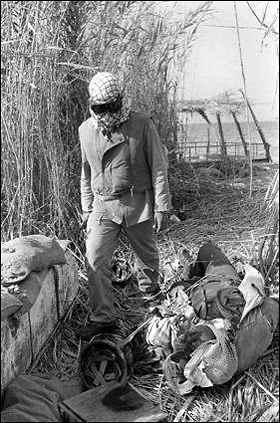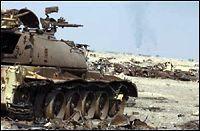 |
 |
| THE ASSOCIATED PRESS, 1985 |
| An unidentified Iranian in the Al-Huweizeh marshlands walks past the body of a soldier killed during the Iran-Iraq war. Both sides suffered heavy losses and border disputes went unresolved. |
 |
2 WARS, NO WINS
Saddam's attempts at expansion bring death and suffering but no gains for Iraqis.
U.S. foreign policy after Sept. 11, 2001 was clear-cut for awhile.
Under Saddam Hussein, Iraq has provoked two wars that left the country in a shambles, its economy in tatters and its people in poverty.
Iraqi forces marched into Iran in the fall of 1980. By the time the weary troops laid down their arms eight years later, the Iran-Iraq War had cost an estimated 1 million casualties on both sides — including 250,000 Iraqi dead — and the country was $46 billion in debt.
Iraq touched off the Persian Gulf War when it invaded tiny Kuwait to the south in 1990, declaring it a province of Iraq. The country emerged from a six-week battle with a U.S.-led coalition with tens of thousands of war dead and its infrastructure trashed.
The road to Saddam's war with Iran probably began in 1979, when an Islamic revolution ousted the Shah of Iran. Saddam probably viewed the situation of his next-door neighbor as both a threat and an opportunity.
The downfall of the monarchy and chaos in Iran following the revolution would have suited Saddam's ambitions to leadership in the Arab world. It also gave him the opportunity to gain sole control over the Shatt Al Arab waterway at the confluence of the Tigris and Euphrates rivers that provides Iraq its only access to the Persian Gulf.
But there also were cultural and religious reasons for animosity between the two nations.
The Iranian revolution had pitted the monarchy against the Ayatollah Khomeini, a fiery religious leader of the Shia sect of Islam who had lived in exile in Iraq until Saddam deported him to Paris. He returned to Iran soon after.
SHIITES VS. SUNNIS
Iranians and Iraqis both are predominantly Muslim. But the majority of Iranians are Shiite fundamentalists. And, while the majority of Iraqis are also Shiites, the country is run by Sunni Muslims, whose religion is not as dogmatic and whose philosophy of government is secular.
In Iraq, Sunnis form an educated ruling class of land-owners, city-dwellers, merchants, bureaucrats and political and military leaders, while Shiites mostly work the land or perform the menial jobs.
Saddam's Baath party leadership feared the success of Iran's Islamic Revolution would inspire Iraqi Shiites to bring the revolution home and drive the Sunnis from power.
The U.S., also fearing the possible growth of Iran's power, quietly sided with Saddam, and ended up sharing intelligence information and military strategy with the dictator.
Whatever his reasons, on Sept. 23, 1980 — five days after he publicly ripped up a 1975 treaty with Iran setting the boundary between the two countries down the middle of the Shatt al Arab — Saddam sent his troops into Iran.
The war was devastating for Iraqis. Cities in the south like Basra were shelled to ruins. As revenue was increasingly steered to the military, the country's infrastructure — roads, bridges, water systems and power grids — collapsed.
But there was no Shiite insurrection. Bad blood between the Persians of Iran and the Arabs of Iraq dates back to antiquity. Apparently, Iraq's Shiites felt stronger allegiance to Iraq's ethnic Arab Sunnis than they did to the Iranian Shiites.
The war solved nothing. Despite restored diplomatic relations in 1990, the two countries still dispute boundaries.
The Gulf War over Kuwait only exacerbated the already dire situation for Iraqis.
Iraq has a long if lukewarm history of coveting Kuwait. In 1939, Iraqi King Ghazi urged Kuwaitis, who were still under British control, to look to Baghdad for leadership. At that time, there was an invasion plan ready to set in motion, until the playboy king was killed in a sports-car accident, which many Iraqis blamed on Britain.
 |
 |
| STEPHANIE SINCLAIR / CHICAGO TRIBUNE |
| Destroyed Iraqi tanks line Safwan Road, also known as "the highway of death" due to casualties inflicted by U.S. troops in the Gulf War. |
 |
In 1973, Iraq briefly occupied a frontier post in northeastern Kuwait, leaving under pressure from the Arab League.
But money, not territory, was apparently behind Saddam's 1990 invasion of Kuwait.
The oil-rich Gulf states, including Kuwait, had helped finance the Iran-Iraq War and were demanding repayment. At the same time the price of oil, which supported what was left of Iraq's crippled economy, was low. Saddam accused Kuwait of deliberately flooding the market with oil to pressure him and of stealing oil from pockets lying beneath Iraq.
The war lasted six weeks. Iraqi forces crumpled before a United Nations force led by the U.S., and the country once again was devastated.
Legacy of war?
Medical problems blamed on uranium munitions used during the Gulf War.
Iraqi doctors blame depleted uranium used by the United States during the Gulf War for what they say is a sharp increase in medical problems.
Doctors say they've noticed a surge in cancers and birth defects — including infants born without brains, sexual organs or spines — since 1991, especially in southern Iraq where the munitions were widely used.
The U.S. uses depleted uranium, an extremely dense byproduct of enriched uranium used in nuclear reactors and bombs, to harden armor-piercing shells and missiles. It first used the DU munitions during the Gulf War, using more than 270 tons, according to NATO.
The U.S. says that the danger from the weak DU radiation is negligible. However, critics say that while there is no danger from touching it, DU can cause harm if it enters the body. They say the exploding shells spew oxidized DU particles that are easily inhaled.
Depleted uranium is mildly radioactive and has a half-life of 4.5 billion years. The Pentagon said two years ago that some such munitions were contaminated with more highly radioactive substances, such as plutonium.
U.S. veterans groups also believe the toxic metal may be linked to Gulf War syndrome, a collection of symptoms reportedly suffered by many veterans after the war. Its cause has never been uncovered.
U.N. investigators also have discovered a surprising level of radioactivity in Serbia, where DU munitions were used in the 1990s.



